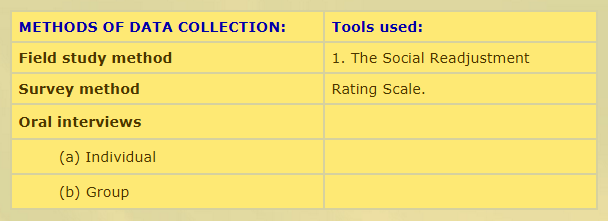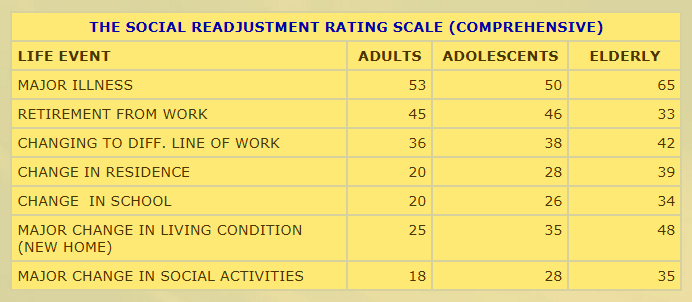Assessment of the Psychological Impact in Relation to Sarsatali Coal Mining Project
Aims of the Study :
The main aim of the study is to ascertain the extent of stress of the villagers regarding the resettlement, their overall attitude towards the same and their coping mechanism.
The studies were done with the help of the field workers of ASHA in two villages namely Mouldanga, and Diguli. The socio-demographic details of the same were also provided by ASHA for further evaluation and preparing this report.
Introduction and Review of Literature
The term stress has many definitions (Lazarus & Flockman, 1984). We will define stress as an internal state, which can be caused by physical demands of the body or by environmental and social situations which are evaluated as potentially harmful, uncontrollable, or exceeding resources for coping. The physical, environmental and social causes of stress state are termed stressors. Once induced by stressors the internal stress state can then lead to various responses. On the one hand it can result in a number of physical bodily responses. On the other hand, psychological responses such as anxiety, hopelessness, depression, irritability and general feeling of not being able to cope with the world can result from the Stress State.
Stress is a big problem in our society (Sharma et. al 1996) some 45% of bodily disease is said to be stress related (Shah et. al. 1980). For example stress is often a cause of heart disease (Type A/ Type B behaviors) and cancer, two of the leading cause of death in India. Further more, stress related diseases cost American industry billions of dollars a year. ; several billion tranquilizers pills are prescribed in the United States each year (Clifford T. Morgan 1986).
Almost any change in the environment demands some coping; a little stress is useful in helping us adapt. But beyond some point stress becomes distress. What acts to produce distress varies greatly from person to person. Chief among these are physical or mental injuries, annoying events in our environments, major changes or transitions in life which force us to cope new ways of life.
Changes in ones life are important stressors (T.H. Holmes 1984). We have used The Social Readjustment Rating Scale in our study report. An indication of stressor strength, based on the judgments of adult’s (Holmes & Rahe, 1967) adolescent (Ruch & Holmes, 1971), and elderly people (Muhlen Kamp et.al. 1975) is given under the headings of “life change units.” By adding the life change units during a year, a life crisis score can be obtained for that year. As the severity of life crises increases from mild (150-199 life change units), to moderate (200-299 life change units), to major (over 300 life change units), susceptibility of illness rises progressively (Holmes & Musuda 1974).
METHOD
Two villages named Diguli and Mouldanga were surveyed separately which includes 8 persons (6 males and 2 females) in the host village of Mouldanga and 7 persons (6 males and 1 female) in Diguli. The subject sample are divided into three groups of adolescent, adult and elderly. Random sampling method was adopted in both the villages. The study report of the individual village is given below -
Village Diguli
According to the Social Readjustment Rating Scale it was observed that 2 elderly is suffering from major physical illness and the idea of resettlement at this juncture of age is not welcomed by them . 2 of the 7 subjects,1 adult and 1 elderly had taken voluntary retirement and it was also reported that 9 other villagers had taken voluntary retirement for their instant financial gratification. The idea of resettlement i.e.. change in residence and new home is welcomed by all except 2 elderly who are physically ill. The 2 adolescent are mentally prepared for this resettlement and change in school in the new Mouldanga area. Interviewing the subjects separately about the ongoing process of resettlement observed that all of them are well communicated about the change that will follow the process and they are well informed about the resettlement idea.
Village Mouldanga
According to the Social Readjustment Rating Scale it was observed that 1 elderly had a major physical illness. It was also reported that an middle age women is pregnant and thus had retired from work due to her health ground. Interviewing the subject’s separately about the ongoing process of resettlement observed that all of them are well communicated about the change that will follow the process. It was also observed that all the subjects are personally involved in the whole action. It was also noticed that they are using cognitive , or thinking meshanism such as reappraisal of the situation to deal with the stressor and thus the coping mechanism of the elderly and the adults are well.
RESULT AND DISCUSSION
In our study it was seen that majority of our subjects suffered from mild to moderate stress except three elderly who suffered from major stress. In all the three cases each suffered from major illness during the year and so the life change units increased above 300 in the Social Readjustment Rating Scale.
Not only changes, but many on going stressors are also noted in this study. These include pollution, noise, health, and finances, which have been related to bodily illnesses and frustrations.
In this study it was also seen that most of the subjects are very well communicated about the idea of resettlement. They are well informed about the changes that are going to occur in this process. Although they are suffering from mild to moderate stress they have adopted a very well coping mechanism.
On detailed interview it was seen that some people are better than others at coping with stressors. The most important result of this study was that most of the subject mainly the elderly and the adults had coped up very well. The reasons for this healthy coping mechanism are:
They were well informed about the process of resettlement.
They are prone to take direct action.
They are involved personally in the whole action.
They are advised not to deal the stressor by impulsive behavior.
They are using cognitive, or thinking mechanism- such as reappraisal of the situation to deal with the stressor.
CONCLUSION
This study reveals that although the subjects are suffering from mild to moderate stressors according to the Social Readjustment Rating Scale, majorities has developed ways of coping with stressors and are responding adaptively.
LIMITATION OF THE STUDY/ CRITICAL EVALUATION
Smaller group of samples
Usage of only one rating scale
No cross cultural evaluation
No controlled group for study
SUGGESTIONS
Group discussions at regular intervals with special emphasis on stress handling and coping management.
Regular health detection camps for physical and behavioral abnormalities
Maintaining a warm and cordial relationship.
The aim of the study was to ascertain the extent of stress regarding the resettlement, their attitudes and the coping mechanism. Both individual and group interviews using the social readjustment rating scale. Seven (7) persons of which six were males, belonging to adolescent, adult and elderly age group were randomly chosen. The aged do not welcome the idea of resettlement. The rest welcome the change which is expected to bring newness in their lives. Except a few women, every body in the santhal village knows that resettlement is a fait accompli and they have already accepted the fact. It is also their consciousness that coal mining would result in sound, dust and other environmental pollution and it was better to leave the present place. However they aspire for a better resettlement. They also know that CESC will build houses for them which has given a sense of security, though the emotional attachment with their ancestral houses still remain. In light of resettlement, the villagers now do not repair their houses and stopped purchasing livestock. The coping mechanism has been especially assisted by the prospect of having better living standards.


